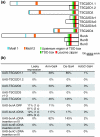Madm (Mlf1 adapter molecule) cooperates with Bunched A to promote growth in Drosophila
- PMID: 20149264
- PMCID: PMC2871527
- DOI: 10.1186/jbiol216
Madm (Mlf1 adapter molecule) cooperates with Bunched A to promote growth in Drosophila
Abstract
Background: The TSC-22 domain family (TSC22DF) consists of putative transcription factors harboring a DNA-binding TSC-box and an adjacent leucine zipper at their carboxyl termini. Both short and long TSC22DF isoforms are conserved from flies to humans. Whereas the short isoforms include the tumor suppressor TSC-22 (Transforming growth factor-beta1 stimulated clone-22), the long isoforms are largely uncharacterized. In Drosophila, the long isoform Bunched A (BunA) acts as a growth promoter, but how BunA controls growth has remained obscure.
Results: In order to test for functional conservation among TSC22DF members, we expressed the human TSC22DF proteins in the fly and found that all long isoforms can replace BunA function. Furthermore, we combined a proteomics-based approach with a genetic screen to identify proteins that interact with BunA. Madm (Mlf1 adapter molecule) physically associates with BunA via a conserved motif that is only contained in long TSC22DF proteins. Moreover, Drosophila Madm acts as a growth-promoting gene that displays growth phenotypes strikingly similar to bunA phenotypes. When overexpressed, Madm and BunA synergize to increase organ growth.
Conclusions: The growth-promoting potential of long TSC22DF proteins is evolutionarily conserved. Furthermore, we provide biochemical and genetic evidence for a growth-regulating complex involving the long TSC22DF protein BunA and the adapter molecule Madm.
Figures





Similar articles
-
Bunched, the Drosophila homolog of the mammalian tumor suppressor TSC-22, promotes cellular growth.BMC Dev Biol. 2008 Jan 28;8:10. doi: 10.1186/1471-213X-8-10. BMC Dev Biol. 2008. PMID: 18226226 Free PMC article.
-
Bunched and Madm Function Downstream of Tuberous Sclerosis Complex to Regulate the Growth of Intestinal Stem Cells in Drosophila.Stem Cell Rev Rep. 2015 Dec;11(6):813-25. doi: 10.1007/s12015-015-9617-5. Stem Cell Rev Rep. 2015. PMID: 26323255 Free PMC article.
-
The Drosophila homolog of human tumor suppressor TSC-22 promotes cellular growth, proliferation, and survival.Proc Natl Acad Sci U S A. 2008 Apr 8;105(14):5414-9. doi: 10.1073/pnas.0800945105. Epub 2008 Mar 28. Proc Natl Acad Sci U S A. 2008. PMID: 18375761 Free PMC article.
-
TGF-beta family signal transduction in Drosophila development: from Mad to Smads.Dev Biol. 1999 Jun 15;210(2):251-68. doi: 10.1006/dbio.1999.9282. Dev Biol. 1999. PMID: 10357889 Review.
-
[Impact of Drosophila protein interaction map].Tanpakushitsu Kakusan Koso. 2004 Jul;49(9):1302-10. Tanpakushitsu Kakusan Koso. 2004. PMID: 15242057 Review. Japanese. No abstract available.
Cited by
-
The RNA-binding proteins FMR1, rasputin and caprin act together with the UBA protein lingerer to restrict tissue growth in Drosophila melanogaster.PLoS Genet. 2013;9(7):e1003598. doi: 10.1371/journal.pgen.1003598. Epub 2013 Jul 11. PLoS Genet. 2013. PMID: 23874212 Free PMC article.
-
The novel tumour suppressor Madm regulates stem cell competition in the Drosophila testis.Nat Commun. 2016 Jan 21;7:10473. doi: 10.1038/ncomms10473. Nat Commun. 2016. PMID: 26792023 Free PMC article.
-
NRBP1 and TSC22D proteins impact distal convoluted tubule physiology through modulation of the WNK pathway.bioRxiv [Preprint]. 2024 Dec 19:2024.12.12.628222. doi: 10.1101/2024.12.12.628222. bioRxiv. 2024. Update in: Sci Adv. 2025 Jul 18;11(29):eadv2083. doi: 10.1126/sciadv.adv2083. PMID: 39764004 Free PMC article. Updated. Preprint.
-
High NRBP1 expression promotes proliferation and correlates with poor prognosis in bladder cancer.J Cancer. 2019 Jul 10;10(18):4270-4277. doi: 10.7150/jca.32656. eCollection 2019. J Cancer. 2019. PMID: 31413746 Free PMC article.
-
Nuclear receptor binding protein 1 correlates with better prognosis and induces caspase-dependent intrinsic apoptosis through the JNK signalling pathway in colorectal cancer.Cell Death Dis. 2018 Apr 1;9(4):436. doi: 10.1038/s41419-018-0402-7. Cell Death Dis. 2018. PMID: 29567997 Free PMC article.
References
-
- Shibanuma M, Kuroki T, Nose K. Isolation of a gene encoding a putative leucine zipper structure that is induced by transforming growth factor beta 1 and other growth factors. J Biol Chem. 1992;267:10219–10224. - PubMed
-
- Nakashiro K, Kawamata H, Hino S, Uchida D, Miwa Y, Hamano H, Omotehara F, Yoshida H, Sato M. Down-regulation of TSC-22 (transforming growth factor beta-stimulated clone 22) markedly enhances the growth of a human salivary gland cancer cell line in vitro and in vivo. Cancer Res. 1998;58:549–555. - PubMed
-
- Shostak KO, Dmitrenko VV, Vudmaska MI, Naidenov VG, Beletskii AV, Malisheva TA, Semenova VM, Zozulya YP, Demotes-Mainard J, Kavsan VM. Patterns of expression of TSC-22 protein in astrocytic gliomas. Exp Oncol. 2005;27:314–318. - PubMed
Publication types
MeSH terms
Substances
LinkOut - more resources
Full Text Sources
Molecular Biology Databases

